
PREV ARTICLE
NEXT ARTICLE
FULL ISSUE
PREV FULL ISSUE
CNG AUCTION 99 CLOSES MAY 13, 2015
Kerry Wetterstrom of CNG forwarded a press for the firm's upcoming Auction 99. Thanks. It was too lengthy to include in its entirety,
but here are some excerpts. -Editor
Classical Numismatic Group of Lancaster, Pennsylvania and London, England is proud to present Auction 99, an Internet and Mail Bid Sale closing electronically on Wednesday, May 13, 2015, from 10 AM ET (U.S.). CNG 99 features 1318 lots of ancient Greek, Celtic, Oriental Greek, Central Asian, Roman Provincial, Roman Republican, and Roman Imperial coinage. Additionally, there are featured selections of Byzantine, Early Medieval, Islamic, World Coinage & Medals, and British Coinage & Medals. The pre-sale estimate total for CNG 99 is $1,805,000. The Greek section of the sale features coins from the collection of Alexandre Carathéodory Pasha (1833-1906), a very rare Starr Group IV silver didrachm of Athens, a prototype gold stater of Kroisos, an offering of previously unknown silver staters of Phaselis, and an extremely rare ‘Horned Horse’ type silver tetradrachm of Antiochos I from the Aï Khanoum mint. Other highlights include a selection of rare Arabian coins, a very rare Antioch silver tetradrachm of Tiberius and Divus Augustus, an important offering of tetradrachms of Aelia Capitolina, and an exceptional Social War silver denarius from the Marsic Confederation. The Roman section of the sale features a diverse selection of Roman Imperial gold coinage, which includes the third known Severus II gold aureus from the Alexandria mint. Byzantine coins from the collection of Prue Morgan Fitts, author of The Beginner’s Guide to Identifying Byzantine Coins, are featured in CNG 99, as well as Axumite coins from the Joan Wilde collection. Joan Wilde died last November, and was the wife of the late Adna G. Wilde, who served as the American Numismatic Association’s Executive Director (1968-72), President (1981-83), Treasurer (1983-2008), and Parliamentarian (1994-2008). Joan usually accompanied her husband to ANA conventions and other coin shows, and she became interested in the coinage of Ethiopia’s ancient Axumite Empire. World coinage in CNG 99 is highlighted by French Feudal issues from the Michael Joffre collection. One of four known Anglo-Saxon gold thrymsas of the ‘Clasped Hands’ type is featured in the British coinage section, and an important 1836 Gobrecht Proof silver dollar from the Dr. Julius Korein collection is offered for the U.S. coin specialist. The Korein Gobrecht dollar is sold on behalf of the American Numismatic Society to benefit their North American Chair. Another highlight of CNG 99 is a Northern California collection of world coins and medals. This collection features a diverse selection of Latin American coinage and proclamation medals, Caribbean cut countermarked issues, German Sede Vacante medals, and Philippine countermarked issues. The Latin American coinage is especially strong in Mexican coinage from colonial to United States issues. Some of the individual highlights from CNG 99 are: Greek Coinage 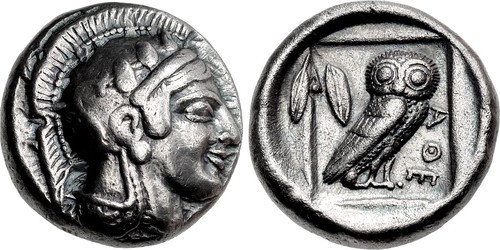
Lot 121–ATTICA, Athens. Circa 475-465 BC. AR Didrachm (19mm, 8.49 g, 11h). Head of Athena right, wearing earring, necklace, and crested Attic helmet decorated with three olive leaves over visor and a spiral palmette on the bowl / Owl standing right, head facing; olive sprig to left, AΘE to right; all but one leaf of olive sprig within incuse square, the totality within incuse circle. Starr Group IV, 142 var. (O122/R– [unlisted rev. die]) = Svoronos, Monnaies, pl. 9, 14 = Seltman 471 = SNG Berry 642 (same obv. die); HGC 4, 1617 corr. (Starr groups; same obv. die as illustration); SNG Copenhagen 30; Boston MFA 1602; Hunterian 10; Rhousopoulos 1979. Good VF, toned, slight granularity. Well centered on a broad flan. Very rare, fewer than 50 didrachms of this type (Starr Groups II–IV) known, of which only about a dozen remain in private hands. Estimated at $15,000 
Lot 198–TROAS, Ophrynion. 4th century BC. AR Tetrobol (15mm, 2.64 g, 12h). Bearded head of Hektor facing, wearing triple crested Attic helmet / Nude youth, holding palm in right hand, rein in left, on horseback right; OΦPYNEΩN above. SNG Ashmolean –; SNG von Aulock 7630; SNG Copenhagen –; SNG München –; BMC –; Traite II 2420 = MG 176. Good VF, darkly toned. Extremely rare, perhaps the third and probably the finest known. Estimated at $3,000 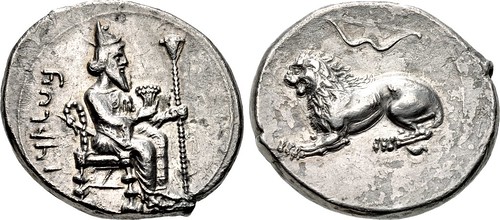
Lot 315–CILICIA, Tarsos. Mazaios. Satrap of Cilicia, 361/0-334 BC. AR Stater (22.5mm, 10.57 g, 5h). Crowned figure of Artaxerxes III in the guise of Baaltars seated right on throne with back terminating in swan’s head, holding lotus flower in right hand, lotus-tipped scepter in left; B’LTRZ (in Aramaic) to left, M (in Aramaic) to lower right / Lion recumbent left; bow above. Casabonne Series 6; Newell, Myriandros 1; SNG France 422 var. (legend retrograde; Myriandros); SNG Levante Supp. 26 (this coin; Myriandros); Jameson 1621 var. (legend retrograde). Near EF, toned, minor roughness on reverse. Very rare, and only the second specimen at auction since NFA XXV in 1990 (Triton XVIII, lot 88 [realized $30,0000] was the first). Estimated at $10,000 From the Edoardo Levante Collection. Ex Numismatic Fine Arts XXV (29 November 1990), lot 186. The attribution of the walking-lion series of Mazaios had originally been given to the mint of Tarsos, but Newell argued that they more likely were struck at Myriandros in his study of that mint in AJN 53 (1919). Later, J.D. Bing, in AJN 1 (1989), argued for an alternative attribution of the Myriandros coinage to the mint of Issos. While most numismatic works continue to follow Newell, Casabonne’s significant study of Cilicia during the Persian period convincingly returns these coins of Mazaios to the mint of Tarsos (cf. Casabonne, pp. 215–7). The appearance of Baaltars on this issue is significantly different from the relatively standard depiction of the deity on other coins of Tarsos. While the deity is typically shown nude to his waist, here the figure is fully clothed with attire that closely resembles that on the figure that appears on the royal Persian coinage struck at Sardes. More significant, though, is the headdress on the figure. Baaltars typically wears a laurel wreath or no headdress, while this portrait shows the figure wearing an elaborate headdress. In a recent article, Frank Kovacs analyzed the type, and argued that this figure is actually the Great King Artaxerxes III Ochos, in the guise of Baaltars, and the headdress is the combined crown of Upper and Lower Egypt, thus his appearance here is as pharaoh of Egypt (cf. F. Kovacs, "Two Persian Pharaonic Portraits" in JNG L [2000]; see also M. Thompson, in MN XII [1968], pp. 11–2, who notes the figure wearing a "high crown of Egyptian type"). This is plausible, as Artaxerxes was the first pharaoh of the Thirty-First Dynasty of Egypt, and the date of his rule there, 343-338 BC, comports well with this issue under Mazaios. O. Casabonne, while acknowledging that the figure here may represent a synthesis of Baaltars and the Great King, disagrees with the identification of the headdress as the Egyptian crown. Instead, he views the headdress as being a Phrygian style cap that is often depicted in contemporary art as being worn by warriors (cf. Casabonne, p. 121, fig. 8), but is here shown with the cheek guards in a raised position. Nonetheless, it is doubtless that the figure here is a synthesized portrait of Baaltars and the Persian Great King. The fractional silver of this issue (see Triton XVIII, lot 89), interestingly, may be most instructive, as the headdress on the figure is shown wearing a crown that is identical to that on the figure of the royal Achaemenid coinage and his robes have interlocking circles reminiscent of the darics of Carradice Type IV Late (cf. M. Thompson, op. cit., p. 12). Roman Provincial Coinage 
Lot 441–PONTUS, Neocaesarea. Severus Alexander. AD 222-235. Æ (30mm, 15.36 g, 12h). Dated CY 163 (AD 226/7). Laureate and cuirassed bust right / Two-storied portico (nymphaeum?) with central arch in which stands Tyche holding rudder and cornucopia; ЄT PΞΓ (date) in exergue. Çizmeli – (D3/R– [unlisted rev. die]); Price & Trell fig. 71 (for rev.). VF, attractive earthen green patina. Fine style portrait and exceptional reverse. Very rare. Estimated at $1500 Çizmeli cites only three specimens with this reverse type, all of which were paired with a cruder obverse die engraved with a more youthful bust. Price and Trell (pp. 43-4) include this type with other coins depicting nymphaea, but caution that “...the building at Neocaesarea resembles a gate more than a fountain and certainly does not have the spouts at the base to indicate the nature of the monument.” Roman Imperial Coinage 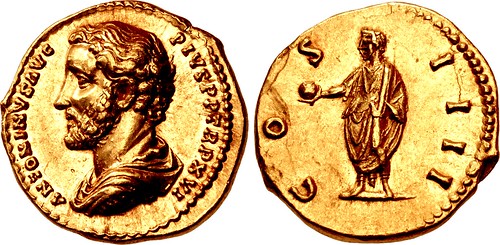
Lot 641–Antoninus Pius. AD 138-161. AV Aureus (19.5mm, 7.31 g, 6h). Rome mint. Struck AD 152-153. ΛNTONINVS ΛVG PIVS P P TR P XVI, bareheaded, draped, and cuirassed bust left / COS IIII, Antoninus Pius standing left, holding globe and volumen. RIC III 226e; Strack 257; Calicó 1523 = Biaggi 714 (same obv. die); BMCRE 798 (same obv. die). EF, underlying luster, a tiny contact mark on obverse, a pair of light scratches on reverse. Wonderful portrait. Estimated at $7500 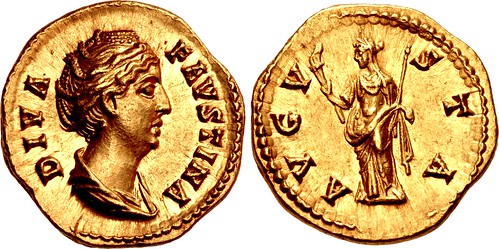
Lot 649–Diva Faustina Senior. Died AD 140/1. AV Aureus (20mm, 7.29 g, 6h). Rome mint. Struck under Antoninus Pius, circa AD 146-161. DIVA FAVSTINA, draped bust right, wearing hair bound in pearls / AVGV STA, Ceres, veiled, standing left, holding torch in right hand and scepter in right. RIC III 356a (Pius); Beckmann dies df21/CA21; Strack 469; Calicó 1763a; Biaggi 812; BMCRE 395 and 397 (Pius). Superb EF, lustrous. Estimated at $15,000 Printed catalogs for CNG 99 are now available. To order a catalog, please visit www.cngcoins.com. Catalogs are $50 to North American addresses, and $75 to the rest of the world. Payment may be made by U.S. $ check or Visa/MasterCard. Catalogues have been mailed to customers on CNG’s active mailing list. Prospective bidders may also view the virtual catalog at CNG 99 Virtual Catalog. For further details and any additional information, please contact CNG, Inc. at: Classical Numismatic Group, Inc. 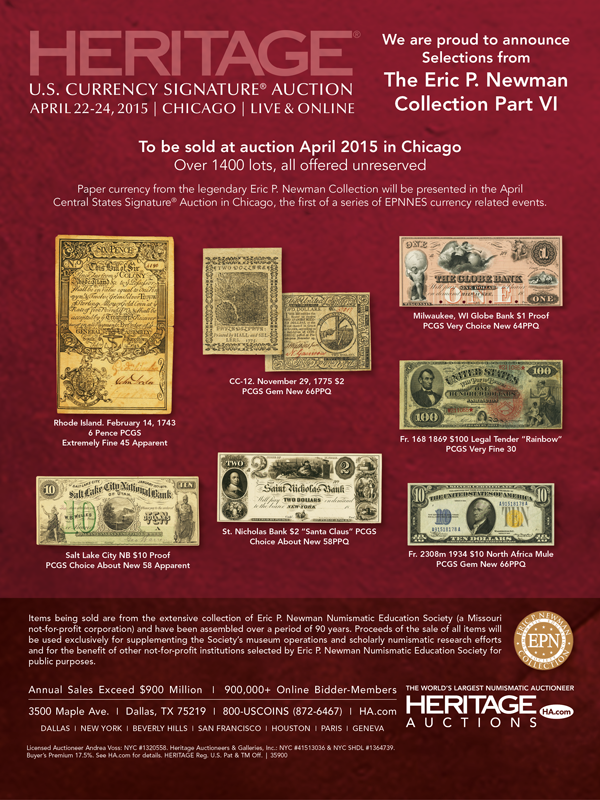
Wayne Homren, Editor The Numismatic Bibliomania Society is a non-profit organization promoting numismatic literature. See our web site at coinbooks.org. To submit items for publication in The E-Sylum, write to the Editor at this address: whomren@gmail.com To subscribe go to: https://my.binhost.com/lists/listinfo/esylum All Rights Reserved. NBS Home Page Contact the NBS webmaster 
|